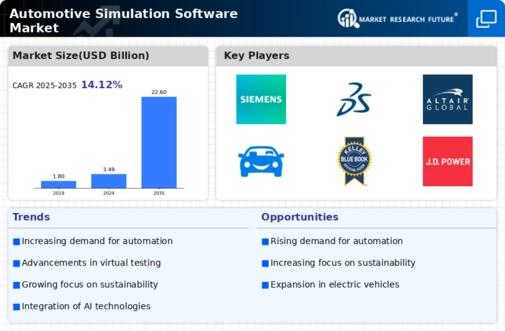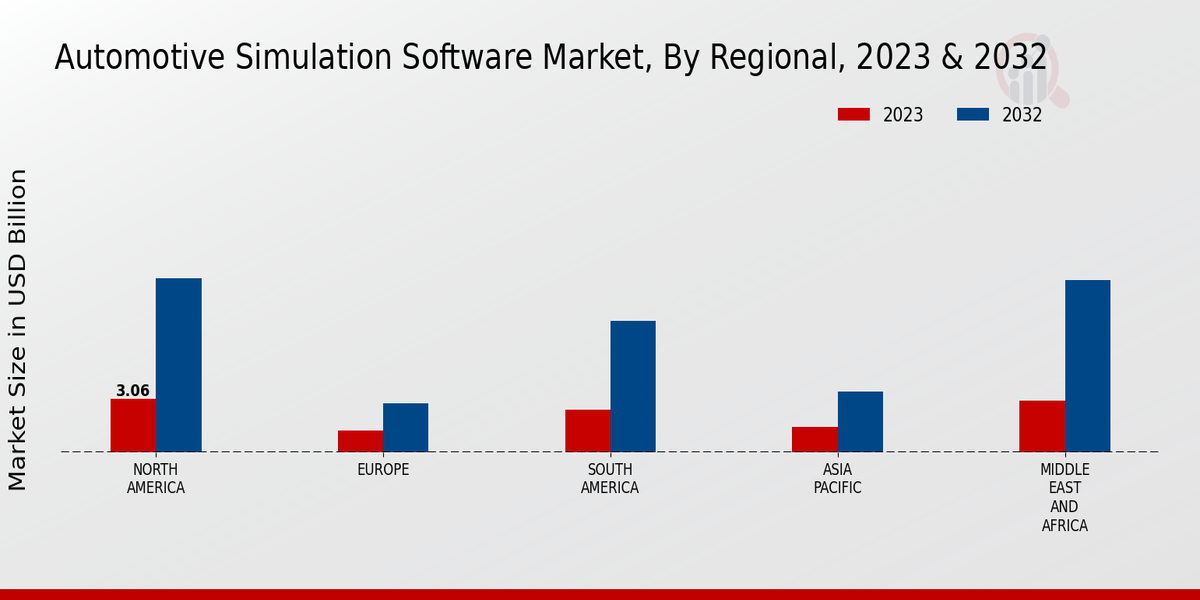Market Growth Projections
The Global Automotive Simulation Software Market Industry is experiencing robust growth, with projections indicating a market size of 3.49 USD Billion in 2024 and an anticipated increase to 22.6 USD Billion by 2035. This growth trajectory suggests a compound annual growth rate (CAGR) of 18.52% from 2025 to 2035. Such figures highlight the increasing reliance on simulation software as automotive manufacturers seek to enhance vehicle performance, safety, and compliance with evolving regulations. The market's expansion reflects broader trends in the automotive sector, including the rise of electric vehicles and advancements in autonomous driving technologies.
Rising Demand for Electric Vehicles
The increasing global emphasis on electric vehicles (EVs) significantly drives the Global Automotive Simulation Software Market Industry. As manufacturers strive to enhance EV performance, simulation software becomes essential for optimizing battery efficiency, thermal management, and overall vehicle dynamics. In 2024, the market is projected to reach 3.49 USD Billion, reflecting the industry's shift towards sustainable mobility solutions. The integration of advanced simulation tools aids in reducing development costs and time, allowing manufacturers to respond swiftly to consumer demands. This trend is expected to accelerate as the global automotive landscape transitions towards electrification.
Regulatory Compliance and Safety Standards
Stringent regulatory frameworks and safety standards imposed by governments worldwide significantly influence the Global Automotive Simulation Software Market Industry. Manufacturers are increasingly required to demonstrate compliance with safety regulations, necessitating the use of simulation software for crash testing and safety assessments. This trend is particularly evident in regions with rigorous automotive regulations, where simulation tools facilitate the evaluation of vehicle performance under various conditions. As the industry evolves, the demand for simulation software that can accurately model safety scenarios is likely to grow, ensuring that vehicles meet the necessary standards before reaching consumers.
Advancements in Autonomous Driving Technology
The rapid evolution of autonomous driving technology serves as a crucial driver for the Global Automotive Simulation Software Market Industry. As automakers invest heavily in developing self-driving capabilities, simulation software plays a pivotal role in testing and validating complex algorithms in a virtual environment. This approach allows for the safe evaluation of various driving scenarios without the risks associated with real-world testing. The anticipated growth of this sector is underscored by projections indicating a market expansion to 22.6 USD Billion by 2035, suggesting that simulation tools will be integral in ensuring the safety and reliability of autonomous vehicles.
Growing Focus on Vehicle Electrification and Sustainability
The global push for sustainability and vehicle electrification is a significant driver of the Global Automotive Simulation Software Market Industry. As automakers prioritize eco-friendly solutions, simulation software aids in the design and optimization of electric and hybrid vehicles. This focus on sustainability not only aligns with consumer preferences but also addresses regulatory pressures for reduced emissions. The market's growth trajectory is evident, with projections indicating a compound annual growth rate (CAGR) of 18.52% from 2025 to 2035. This trend underscores the importance of simulation tools in developing innovative solutions that meet both environmental and performance standards.
Integration of Artificial Intelligence and Machine Learning
The integration of artificial intelligence (AI) and machine learning (ML) technologies into automotive simulation software is transforming the Global Automotive Simulation Software Market Industry. These technologies enhance the predictive capabilities of simulation tools, allowing for more accurate modeling of vehicle behavior and performance. By leveraging AI and ML, manufacturers can optimize designs and improve efficiency throughout the development process. This trend aligns with the broader industry shift towards data-driven decision-making, where simulation software becomes a vital component in the design and testing phases. As a result, the market is poised for substantial growth, driven by the increasing adoption of these advanced technologies.



















